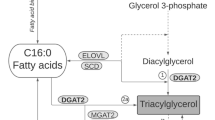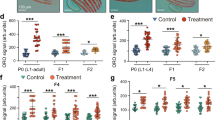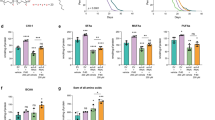Abstract
Meat products are generally low in omega-3 (n-3) fatty acids, which are beneficial to human health. We describe the generation of cloned pigs that express a humanized Caenorhabditis elegans gene, fat-1, encoding an n-3 fatty acid desaturase. The hfat-1 transgenic pigs produce high levels of n-3 fatty acids from n-6 analogs, and their tissues have a significantly reduced ratio of n-6/n-3 fatty acids (P < 0.001).
This is a preview of subscription content, access via your institution
Access options
Subscribe to this journal
Receive 12 print issues and online access
$209.00 per year
only $17.42 per issue
Buy this article
- Purchase on Springer Link
- Instant access to full article PDF
Prices may be subject to local taxes which are calculated during checkout

Similar content being viewed by others
References
Simopoulos, A.P. (ed). World Rev. Nutr. Diet. 83 (1998).
Simopoulos, A.P. & Cleland, L.G. (eds). World Rev. Nutr. Diet. 92 (2003).
Spychalla, J.P., Kinney, A.J. & Browse, J. Proc. Natl. Acad. Sci. USA 94, 1142–1147 (1997).
Kang, J.X., Wang, J., Wu, L. & Kang, Z.B. Nature 427, 504 (2004).
Dai, Y. et al. Nat. Biotechnol. 20, 251–255 (2002).
Lai, L. et al. Science 295, 1089–1092 (2002).
Howe, P.R.C. World Rev. Nutr. Diet. 83, 132–143 (1998).
Acknowledgements
We thank Angela van Dyke, Kara A. Teacoach and Sarah R. Dellinger for their technical support, James Turk for morphological evaluations and Alan Spire for providing the echocardiograms. This work was supported in part by National Institutes of Health (NIH) grant CA79553 and American Cancer Society grant RSG-03-140-01-CNE (J.X.K.); NIH grant U42 RR018877 and R01 RR013438 (RSP); NIH grant R01DK64207 (Y.D.) and an unrestricted gift to the Thomas E. Starzl Transplantation Institute from the Robert E. Eberly Program for Transplant Innovation.
Author information
Authors and Affiliations
Corresponding authors
Ethics declarations
Competing interests
J.X.K. is the inventor of the patent applications WO05077022A2 and WO02072028A2 whose value may be affected by this publication.
Supplementary information
Supplementary Fig. 1
Photograph of three piglet littermates, hfat-1 transgenic piglets #8 (middle) and #9 (right) and non-transgenic piglet #10 (left), at age of 3 weeks. (PDF 135 kb)
Supplementary Table 1
n-6/n-3 ratios in organs and tissues from piglets #2, #4 and #5. (PDF 8 kb)
Rights and permissions
About this article
Cite this article
Lai, L., Kang, J., Li, R. et al. Generation of cloned transgenic pigs rich in omega-3 fatty acids. Nat Biotechnol 24, 435–436 (2006). https://doi.org/10.1038/nbt1198
Received:
Accepted:
Published:
Issue Date:
DOI: https://doi.org/10.1038/nbt1198
This article is cited by
-
Chitosan-based delivery of fish codon-optimised Caenorhabditis elegans FAT-1 and FAT-2 boosts EPA and DHA biosynthesis in Sparus aurata
Reviews in Fish Biology and Fisheries (2024)
-
Bioproduction of n-3 polyunsaturated fatty acids by nematode fatty acid desaturases and elongase in Drosophila melanogaster
Transgenic Research (2023)
-
Rapid visual genotyping method for germline mutants with small genomic fragment deletion by allele-specific PCR and lateral flow nucleic acid biosensor
Molecular Biology Reports (2021)
-
Efficient base editing by RNA-guided cytidine base editors (CBEs) in pigs
Cellular and Molecular Life Sciences (2020)



